Following the conclusion of Kamen Rider Stronger in 1975, the Kamen Rider franchise seemed to have come to its conclusion. However the success of anime series such as Space Battleship Yamato created a renewed interest in science-fiction and tokusatsu works across Japan, and together with re-runs of the original Kamen Rider series a new boom for the franchise had begun. It wasn't long before producer Tohru Hirayama was put in charge of a brand new instalment, originally intended to be a revival of the original. Kamen Rider (1979) began airing in October 1979 and ran through to the following October, for a total of 54 episodes. To avoid confusion with the original series (as well as the fact it would eventually diverge from being just a revival), it is also known by the names New Kamen Rider and, perhaps best of all, Skyrider.
After protecting acclaimed scientist Doctor Keitarō Shido from kidnapping, student and hang glider Hiroshi Tsukuba is pulled in a sinister scheme by Neo-Shocker - a new evil organisation bent on world domination. After his friends are murdered by a Neo-Shocker assassin, Hiroshi is their next target. Desperate to keep him alive, the Doctor Shido bargains with Neo-Shocker to turn him into their ultimate cyborg warrior. However rather than making him their slave, the Doctor turns Hiroshi into a warrior to fight back against them - a Kamen Rider!
Together with assistance from his friends, Hiroshi battles Neo-Shockers army of cyborgs - commanded by their chiefs General Monster and Admiral Majin. Eventually Hiroshi also crosses paths with the previous seven Kamen Riders - using their training to become even more powerful and take his place among the heroes as Skyrider.
Despite its origins as a "remake" of sorts to the original series, Skyrider manages to get off to a rather memorable start. Since the general Kamen Rider origin story uses the same story beats across the whole of the Showa era, there's enough wiggle room for Skyrider's premiere to find elements that help set it apart. The rather brutal murder of Hiroshi's friends is one such example, as is Dr Shido bargaining for Hiroshi's life rather than him being "selected" for augmentation. The same can be said for Skyrider himself, whose design takes things back to the very basics with a simple grasshopper motif. However the more streamlined design, together with his flight capabilities, immediately make him stand out as his own character even before he's properly given his designation as "Skyrider". If anything the show is more of a "back to basics" in that it isn't trying to reinvent the wheel - refining the feel of Kamen Rider with slicker camerawork and improved action. It isn't quite as raw or imaginative as the original series, but it does show off how far tokusatsu had come visually since those early years. There are of course plenty of cues to the original series in the story though - from more overt things like the choice of monsters in the early episodes to perhaps more coincidental elements like key members of the cast suddenly disappearing to little to no fanfare. Just as you're getting used to the dynamic Dr Shido has with Hiroshi, he's off to join the Anti-Neo-Shocker Committee and never be seen or heard from again.
But as competent as these early episodes may seem, ultimately it didn't seem to be what audiences at the time were looking for in a new Kamen Rider series. Ratings weren't high as expected, and technical effects such as Skyrider's flight proved both difficult and costly to regularly include in the story. To combat this Skyrider underwent a retool - starting with the introduction of a new villain, but more significantly bringing it truly in line with the previous shows. All seven previous Kamen Riders were brought in for a big crossover episode, culminating in the newest Ridr getting a brand new powered-up suit and his official designation as 'Skyrider'. The fun doesn't stop there either, as Skyrider then enters a whole new phase of repeated guest appearances from the veteran Riders. Nearly every episode in this period includes some sort of team up, with almost all of them making out of suit appearances as well. Given that producer Hirayama had previously batted for a multi-Rider series prior to Stronger, in a way finally got his wish here.
The problem is though that as exciting as a stretch of team-up stories may be, the end result feels like it's taking a lot of the spotlight away from Skyrider himself. The show feels less about its titular character, and more the excitement and anticipation of whatever Rider he's going to be teamed up with each week. That excitement shouldn't be downplayed either, because moments like seeing Riderman appear as a solo hero or Rider 2 getting more prominence over his predecessor (something that feels almost unthinkable nowadays) are ones to really savour. But with his flight abilities all but forgotten and the characters that helped prop up those early episodes long gone, Skyrider himself has very little to offer over the far more established heroes. The idea of Skyrider teaming up with his predecessors to learn from them and become his own Rider isn't a bad one, but it's not something the show itself plays around with all that much - instead it often feels more like an opportunity to have two fights going on at once. If you're a fan of the previous six shows then it's hard not to love these episodes, but that enjoyment certainly isn't coming from Skyrider being in the picture.
When Skyrider does finally move away from its reliance on team-up episodes it does gain some of its independence back, and is able to produce some memorable episodes off of its own back. The "Ghost Story Series" is a particularly good example of this - a stretch of six episodes with unrelated stories, but all under a horror motif. There are also small ongoing plot threads to make things interesting, with one monster studying Skyrider's abilities across multiple episodes to determine his weakness before challenging him himself. But while these episodes feel like Skyrider at its strongest, it does also feel sometimes like a case of too little, too late. With previous shows having done a much better job at establishing their characters, they were able to do a lot more with their final stretch of episodes with a lot less.
And that's ultimately the issue with Skyrider, because even when the writing is at its strongest the characters are just ultimately lacking. Hiroshi Tsukuba isn't a bad protagonist by any means, but ultimately lacks that unique quality that makes him stand out from any other 70s tokusatsu hero. It's a shame because the early episodes of the series show some real potential, with Hiroshi painted as a complete contrast to early Takeshi Hongo in the original series. Whereas Hongo laments to the loss of his humanity, Hiroshi holds onto - remarking to a fellow victim of Neo-Shocker's remodelling that even though her body may be modified, her "heart is still human". Had these been carried across the whole series then he'd stand out as a particularly strong lead, but as Skyrider is taken out of the spotlight the more generic he begins to feel. One really nice touch the series has is having Hiroshi present most of the next episode previews, greeting the audience and reminding kids to not try these stunts at home or to stay active during Summer break. They're cute little segments that make Hiroshi that much more affable, but ultimately they aren't part of the show itself - so commending them as one of his most memorable traits almost feels like damning with faint praise.
The fault doesn't just lie with Hiroshi either, because Skyrider has a particularly large cast of supporting characters that mostly prove equally unremarkable. Again there's potential there at the very beginning with Dr Shido, combining both creator and mentor into a single character. The Shido Hang Glide Club is a good reimagining of the Tachibana Racing Club, giving Skyrider a home base of sorts that relates to Hiroshi's own interests. But with Shido's quick departure from the series, things fall much into a far more basic setting and the supporting cast's status as "lesser" versions of what's come before couldn't be more obvious. Shido is replaced with Genjirō Tani, a colleague with his own history with Neo-Shocker. Genjirō owns the Blanco Coffee Shop which serves as Skyrider's new base of operation, and the supporting cast is bolstered with the staff that help run it. Again it's a very similar set up to the original series with a string of female supporting characters and a recurring child character, but here they feel a lot less involved in the storylines. Every so often one will come along where they help kick things off, but for the most part they're there to just stand around and comment on the plot during the Coffee Shop scenes. Even though the girls of the Tachibana Racing Club spent half the time getting captured, at least they were actively doing things.
Skyrider also has a strange fascination with side characters wholly dedicated to comic relief, which wouldn't necessarily be an issue if they didn't feel so superfluous to the show itself. For example the earliest episodes have Imata Tonda - a photojournalist who constantly stumbles into fights between Skyrider and Neo-Shocker (with humorous results). The character isn't really properly introduced, and is dropped from the show pretty swiftly when it undergoes its retool. Later on however it tries a similar thing again with Kanji Yada - a self-proclaimed hero who fights against Neo-Shocker in a customised suit of armour as "GanGan G". Of course under that armour GanGan G is just a man, so most of those "fights" either involve him running away or getting into all sorts of trouble. As someone who can potentially be more actively involved in storylines and build up a dynamic with Hiroshi, GanGan G is a much better fit fit the show than Tonda was. But again Skyrider wastes this by not really doing anything meaningful with him at all. GanGan G is introduced into the show without any real fanfare, doesn't get any sort of focus episodes and is mostly relegated to a short comedy scene each episode. Even if storytelling was a lot less serialised back then, he feels like a character that warrants so much more. In the shows final episodes he is able to have some great conversations with Hiroshi, but they'd have felt so much more earned if he had become someone who actively tried to fight alongside Skyrider (even if it was to Hiroshi's chagrin) rather than them simply bumping into each other each week.
Similar complaints can be directed towards the show's villains as well, despite Skyrider already having the perfect formula to pull from. The joy of Showa Kamen Rider's evil organisations isn't just that it's a powerful and widespread threat for the hero to fight back against, it's the ability to switch out the commanders at frequent intervals. Both the original series and V3 particularly benefitted from this, showcasing a number of great villains while keeping the series fresh. Skyrider on the other hand only has General Monster and Admiral Majin, with the latter dominating two thirds of the show's run. The pair do however compliment each other nicely aesthetically as well as showing off the two sides to Neo-Shocker - General Monster being strongly military-themed while Admiral Majin more flashy and supernatural in design. Again neither are particularly bad characters, but they just don't have a particular charisma to set them apart from your typical ranty supervillain. The final few episodes toy with some interesting ideas for Majin, but that sadly doesn't really lead to anything.
Skyrider's failing isn't that it's bad, it's that it fails to be anything more than simply "competent" despite how much potential it had thrown at it. Despite getting off to a fantastic start as a revived Kamen Rider for a new audience, its lack of a strong cast as well as the somewhat sidelining of its titular character lead to a series that lacks the (Rider) punch of its predecessors. Budget and technical difficulties be damned, dropping your hero's main gimmick less than halfway into the show is never a good sign. While there is still plenty of good to be found in Skyrider and it was at least strong enough to see the franchise carry through into Super-1, the overwhelming sense that it could have been so much more is hard to shake off.




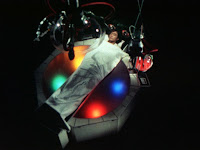




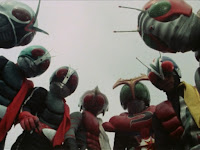
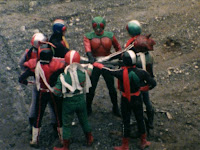
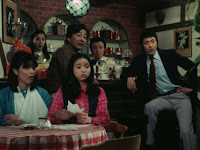


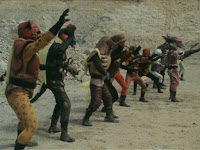

2 comments:
Aw man, this is my favorite Showa entry too
While it still doesn't make the main gimmick being dropped any better, a big reason for it was also that a child got injured doing the stunts at home. The possibility of this was why the whole 'don't try this at home' was emphasised so much, but when a child actually got hurt trying to imitate Skyrider, it was decided to have him stop doing that entirely so that didn't happen again. Again, doesn't make it any better, but I think it's more understandable that they did drop it.
Post a Comment